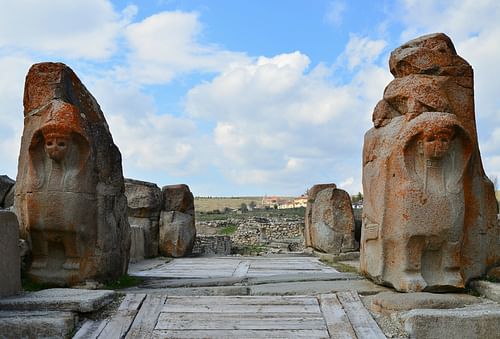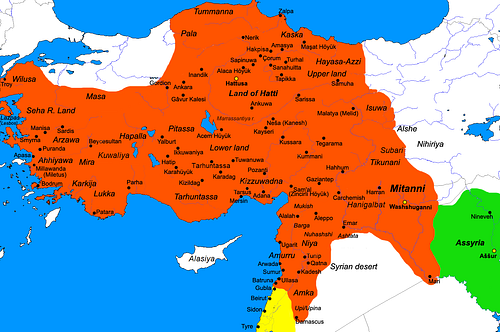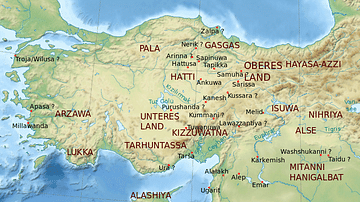
Suppiluliuma I (1344-1322 BCE) is considered the most powerful and impressive king of the Hittite Empire. He was the son of Tudhaliya II (also known as Tudhaliya III) and is credited with founding the New Kingdom of the Hittites (also called the Hittite Empire). His dates are disputed owing to the manner in which the Hittites recorded their history. The scholar Marc van die Mieroop writes, “The Hittites did not leave us king lists with the lengths of reigns, thus even for the creator of the New Kingdom state, Suppiluliuma I, we have different suggestions for his years of rule, varying from twenty-two to forty years…While in practice we assign absolute dates to the individual rulers, these are always approximate” (156). What is clear is that the Old Kingdom of the Hittites had fractured and fallen, and that Suppiluliuma I reformed the flaws in governmental policy which caused the decline, re-conquered the lost territories, and expanded his reign across Anatolia, north toward Mesopotamia, and down to the borders of Egypt.
The Old Kingdom & the Ascent of Suppiluliuma
The Hittite Old Kingdom was founded by Hatusilli I who, by 1650 BCE, had conquered the people known as the Hatti, rebuilt their capital at Hattusa (modern-day Bogazkale, Turkey), and established it as the Hittite capital. Hatusilli I is praised as a great warrior and administrator who expanded Hittite rule throughout the region but, under his grandson, the kingdom began to decline. By the time of Tudhaliya II, the Hittites controlled only the area around Hattusa and a few small cities. The Edict of Telepinu (Telepinu was the last ruler of the Old Kingdom) laments the sorry state of the Hittite Kingdom and records the steady decline from the death of Hatusilli I to Telepinu's reign. Tudhaliya II did little to help matters and, under his reign, the kingdom dwindled further. Van die Mieroop writes, “These setbacks were reversed, however, by Suppiluliuma I who, already under his father Tudhaliya II, proved to be one of the Hittites' ablest military leaders” (159). His success was due to his ability to recognize opportunities and exploit them to his fullest advantage.
The Conquest of Mitanni
The clearest example of Suppiluliuma I's tactics is his conquest of the Mitanni. The Kingdom of Mitanni spread from northern Mesopotamia down through Anatolia (from modern-day Iraq through Turkey), and the Mitanni were important enough to have had alliances with Egypt since the time of Tuthmosis III (1479-1425 BCE). Future Egyptian dynasties continued to regard the Mitanni with respect, and the daughter of the Mitanni King Tushratta was given in marriage to Amenhotep III (1391-1353 BCE) as a lesser wife as part of one of their treaties. Shortly after this, a power struggle in the Mitanni capital of Washukanni between Tushratta and a relative of the previous king, Shuttarna, known as Artatama II, divided the government. Recognizing an opportunity, Suppiluliuma I backed the weaker Artatama II in order to sustain the conflict and overthrow the stronger Tushratta. Egypt, however, backed Tushratta as the legitimate ruler and helped to maintain his regime. Tushratta had almost defeated his rival when Suppiluliuma I completed his successful campaign in Syria and made sure that the Egyptians knew of it; as well as making clear his support for Artatama II. Egypt, recognizing the growing power of the Hittite king and hoping to win favor with him, withdrew its support of Tushratta. Suppiluliuma I, tired of diplomacy and now free to do as he pleased without fear of Egyptian reprisal, led his forces on Washukanni and sacked it. Tushratta was assassinated by his son and Artatama II took the throne.

Much to the dismay of Suppiluliuma I, however, Artatama II was discovered to have pro-Assyrian leanings. The Assyrians, who were no friends of the Hittites, were at this time growing in power in their own right and exploited the fall of Tushratta's regime to make inroads into the region of Mitanni with the support of Artatama II. Suppiluliuma I then withdrew his support of Artatama II and his son Shuttarna III and backed the son of Tushratta, Kili-Teshub. He married one of his daughters to Kili-Teshub, thus linking him to his own house, and marched again on Mitanni, taking Carchemish and Washukanni and establishing Kili-Teshub on the throne. The historian Trevor Bryce notes that this about-face on Suppiluliuma I's part resulted in protests of betrayal by the factions of Artatama II and Shuttarna III but “Suppiluliuma I was never one to let promises he had made, or indeed any considerations of honour, loyalty, or fair play, stand in the way of the achievement of his objectives” (35). Mitanni was conquered, the Assyrians were held at bay (at least for the moment), and Suppiluliuma I had removed a rival nation and expanded his own territory. The region of the Mitanni would henceforth be ruled by Hittite kings until the rise of the Assyrians.
Suppiluliuma & The Egyptian Queen
Recognizing the weakness of an opponent, and making the most of it, was Suppiluliuma I's standard mode of operation and this was again seen in his dealings with Amenhotep III's successor in Egypt, Akhenaten. Shortly after assuming rule in 1353 BCE, Akhenaten abolished the traditional religious observances in Egypt and instituted monotheism. He then withdrew to his new city of Akhetaten and largely ignored foreign policy. Suppiluliuma I sent messages to the new king and, receiving no response, recognized an opportunity and invaded Egypt's vassal states, such as Byblos, claiming them for the Hittite Empire. By the time Akhenaten roused himself and sent his general Horemheb to deal with the Hittites, it was too late. The Hittite army under Suppiluliuma I had grown too strong, while the Egyptian army, which had largely been neglected under Akhenaten's rule, had become weaker than it was under Amenhotep III.
Suppiluliuma I's power grew as he expanded his empire further. By the time of Akhenaten's successor, Tutankhamun, the Hittite Empire rivalled Egypt's, and the Hittite army was the most powerful in the region. Like Akhenaten before him, Tutankhamun sent General Horemheb to deal with the Hittites but to little effect. The Hittites were not strong enough to take Egypt by force and the Egyptians were not powerful enough to drive the Hittites from their borders. Van die Mieroop writes, “[the Hittites] and Egypt saw each other as equals, a sentiment that may have led to the highly unusual request by the recently widowed queen of Egypt for a son of Suppiluliuma I to become her husband” (159). When Tutankhamun died in 1327 BCE, his young wife Ankhsenamun wrote to Suppiluliuma I for help:
My husband has died and I have no sons. They say about you that you have many sons. You might give me one of your sons to become my husband. Never shall I pick out a servant of mine and make him my husband.
This strange entreaty from an Egyptian queen made Suppiluliuma I suspicious. No Egyptian dynasty had ever invited the son of a foreign king to sit on the throne of Egypt. The Hittite king sent an emissary to Egypt to meet with her and ascertain the truth behind her message. The man returned with another letter which read:
Had I a son, would I have written about my own and my country's shame to a foreign land? You did not believe me and you have said as much to me. He who was my husband has died. A son I have not! Never shall I take a servant of mine and make him my husband. I have written to no other country; only to you have I written. They say your sons are many; so give me one of your sons. To me he will be husband, but in Egypt he will be King.
Suppiluliuma, once assured of the legitimacy of the offer, seems to have been more than happy to oblige Ankhsenamun. This was an opportunity he could never have foreseen: the throne of Egypt was within his reach without his having to exert the slightest effort. He quickly sent his son Zananza to Egypt to marry Ankhsenamun; but the prince was killed before reaching the border. His murder has long been understood to be the work of General Horemheb, possibly with the support or collusion of the vizier named Ay.
The Plague & the Death of the King
Suppiluliuma I was enraged at the news of his son's death and threw the entire force of the Hittite army against Egypt. He conquered more territories and carried Egyptian captives back to Hattusa. This proved to be an unfortunate decision on his part, as a plague had been sweeping across Egypt in 1322 BCE and, by bringing the Egyptians back to his capital, Suppiluliuma I brought the plague with them. He died of the plague that same year and his son, Arnuwanda II, who had been groomed by the king as heir, died as well. The rule of the Hittite Empire then fell to the younger son, Mursilli II, who followed his father's example in politics and military prowess. Mursilli II secured the empire's borders and then expanded them further. After his death, however, the empire of the Hittites slowly declined. The kings who followed Mursilli II, although they had some shining moments, never were able to achieve the same objectives nor maintain the empire as Suppiluliuma I or Mursilli II had done. A little over a hundred years after the death of Suppiluliuma I, the Hittite empire was crumbling through repeated attacks by the Sea Peoples and the tribe known as the Kaska. By the year 1200 BCE the empire was gone and the region conquered by the Assyrians.




